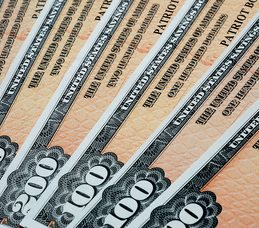 US Savings Bonds are different than other bonds, including Treasury Bonds. They can be redeemed at their full cash value prior to maturity, with only a minimal early redemption penalty. This feature means that holders of savings bonds have protections against interest rate moves and default risk that other bondholders do not.
US Savings Bonds are different than other bonds, including Treasury Bonds. They can be redeemed at their full cash value prior to maturity, with only a minimal early redemption penalty. This feature means that holders of savings bonds have protections against interest rate moves and default risk that other bondholders do not.
Comparing Savings Bonds To US Treasuries
Treasuries have a range of maturity dates, including 7, 10 and 30 years. If you buy a Treasury (either through an auction or from the market), you are guaranteed by the “full faith and credit” of the US government to receive the face value of the bond at maturity. However, what happens if you need to get rid of the bond before maturity? The US government will not pay the face value of the bond before maturity. You will need to sell the bond in the market, where you’re not guaranteed to get back the price you paid for the bond, or even the face value.
US Savings Bonds can only be sold by the US Treasury and cannot be resold in the market. Savings bonds purchased today will mature in 30 years. To compensate for the fact that they cannot be sold and have a long maturity, the Treasury department allows savings bond owners to cash-in their bonds early. Bonds can be cashed in for their full value, the initial investment plus any accrued interest, twelve months after purchase. There is a small penalty if redeemed prior to being held for five years. However, you are guaranteed to get back your full initial investment even if you only hold the bond for the 12 months. (learn more about cashing in savings bonds here.)
How does redemption protect against interest rate and default risk?
(For the sake of simplicity, I will use EE Savings bonds to illustrate these bonds. Its true for I bonds as well but the example become more complicated.)
Let’s say you bought $10,000 of each the following: a 5 year Treasury Note that has a yield of 0.75% and an EE Savings Bond which yields 0.2%. Two years after purchasing the bonds, you need to sell / redeem the bonds. After the early redemption penalty, you would receive $10,035 for the savings bond – regardless of what happened to market interest rates.
For the Treasury note, how much you would receive would be dependent on interest rates. If market interest rates rose by 1%, you might only receive $9,700. Add in the interest to the total (to make an apples to apples comparison) and the number increases to $9,850. Because of the redemption feature, saving bond holders are better off than other bondholders in periods of increasing interest rates.
Default risk. What was only unthinkable a few years ago, the US government defaulting on its debt obligations has become a remote but scary possibility if congress does not approve raising the debt ceiling. A savings bondholder can redeem their bonds in anticipation of this (although it may not be a good idea). On the other hand, a treasury bond holder might have to sell into a jittery market and take a loss to protect themselves from experiencing a default.
Bottom Line: Saving Bonds are unique investments. We recommend I savings bonds for short to medium term investments. For those looking to invest for the long-term, we like combination of I and EE bonds. For more on the different types of savings bonds go here.
Trusted & Regulated Stock & CFD Brokers
What we like
- 0% Fees on Stocks
- 5000+ Stocks, ETFs and other Markets
- Accepts Paypal Deposits
Min Deposit
$200
Charge per Trade
Zero Commission on real stocks
64 traders signed up today
Visit Now67% of retail investor accounts lose money when trading CFDs with this provider. You should consider whether you can afford to take the high risk of losing your money.
Available Assets
- Total Number of Stocks & Shares5000+
- US Stocks
- German Stocks
- UK Stocks
- European
- ETF Stocks
- IPO
- Funds
- Bonds
- Options
- Futures
- CFDs
- Crypto
Charge per Trade
- FTSE 100 Zero Commission
- NASDAQ Zero Commission
- DAX Zero Commission
- Facebook Zero Commission
- Alphabet Zero Commission
- Tesla Zero Commission
- Apple Zero Commission
- Microsoft Zero Commission
Deposit Method
- Wire Transfer
- Credit Cards
- Bank Account
- Paypall
- Skrill
- Neteller
What we like
- Sign up today and get $5 free
- Fractals Available
- Paypal Available
Min Deposit
$0
Charge per Trade
$1 to $9 PCM
Visit Now
Investing in financial markets carries risk, you have the potential to lose your total investment.
Available Assets
- Total Number of Shares999
- US Stocks
- German Stocks
- UK Stocks
- European Stocks
- EFTs
- IPOs
- Funds
- Bonds
- Options
- Futures
- CFDs
- Crypto
Charge per Trade
- FTSE 100 $1 - $9 per month
- NASDAQ $1 - $9 per month
- DAX $1 - $9 per month
- Facebook $1 - $9 per month
- Alphabet $1 - $9 per month
- Telsa $1 - $9 per month
- Apple $1 - $9 per month
- Microsoft $1 - $9 per month
Deposit Method
- Wire Transfer
- Credit Cards
- Bank Account


